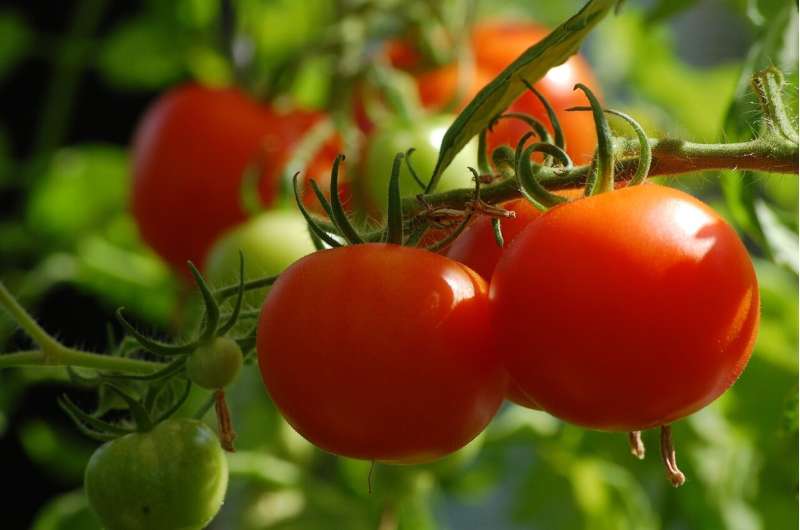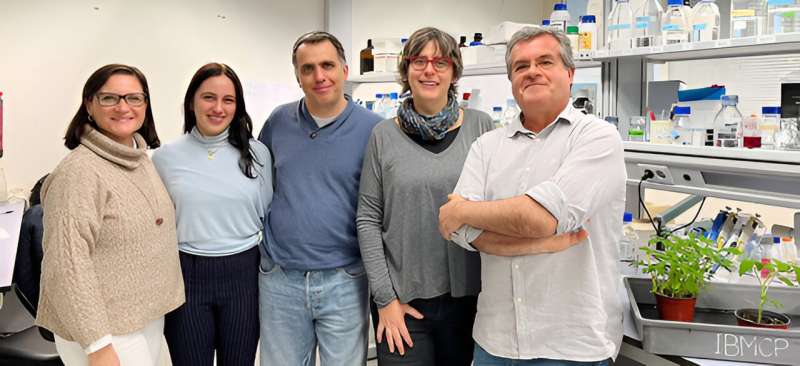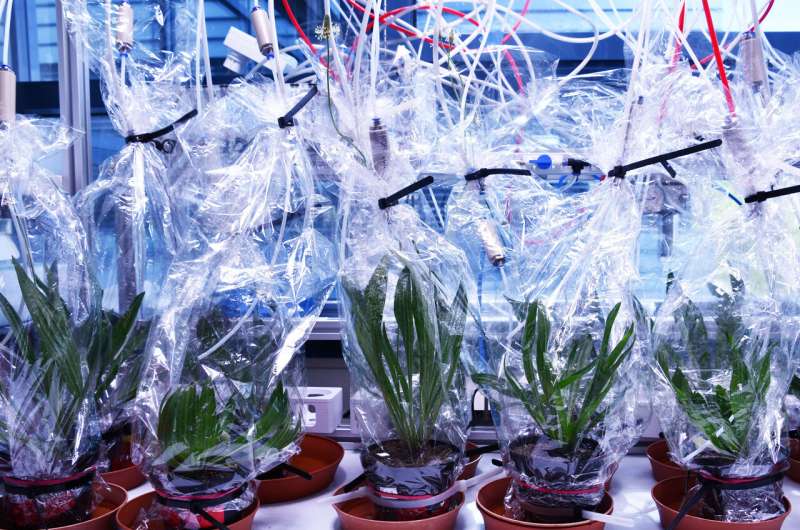Aroma compound found to reduce the effects of drought, improve productivity of tomato plants

Tomato plants emit a scent to resist bacterial attacks. This aroma—or volatile compound—is hexenyl butanoate (HB). A team from the Research Institute for Plant Molecular and Cellular Biology (IBMCP), a joint center of the Universitat Politècnica de Valencia (UPV) and the Spanish National Research Council (CSIC), has discovered that its mode of action is novel, as it works independently of the classic hormone involved in the process of stomatal closure (abscisic acid).
In this way, it is possible to protect plants from threats like drought or pathologies that could threaten crops. The work has been published in Horticulture Research.
"Given the importance of stomatal control in water stress, HB treatments alleviate the symptoms caused by drought and improve the productivity of crops such as tomato. Therefore, in the context of the severe drought we are currently experiencing in Spain, the development of this type of compound is a breakthrough to address this situation," says Purificación Lisón, IBMCP researcher and professor in the Department of Biotechnology at the School of Agricultural Engineering and Environment (ETSIAMN) of the UPV.
Among other advantages, the UPV and CSIC team points out that the HB compound resists diseases that enter the stomata. In the case of tomatoes, its use protects against Pseudomonas syringae. This bacterium causes significant damage, particularly in cold and wet weather, making the fruit unsuitable for marketing.
The IBMCP team has also demonstrated its usefulness in other crops, such as potatoes, where it has increased resistance to Phytophthora infestans. This parasite causes a disease known as late blight or downy mildew, which causes significant losses.

To study the mode of action of the HB compound, the IBMCP team used different strategies: genetic, using biosynthesis mutants in specific molecules; pharmacological, with exogenous treatments with inhibitors of the possible processes involved; biochemical, through the analysis to detect phosphorylations; and transcriptomic, using the new massive sequencing techniques (RNAseq), which allow understanding the reprogramming mechanisms of the treated plants in terms of mRNAs.
"Our results support the use of HB as a bioactive natural compound for more sustainable agriculture. Currently, there are no alternative products on the market that can induce stomatal closure," adds Mª Pilar López Gresa, also a researcher at the IBMCP (CSIC-UPV) and professor at the Biotechnology Department of the ETSIAMN-UPV.
As stomatal closure is involved in a large number of processes in the plant, the IBMCP team is investigating new uses for HB, such as synchronizing flowering, inducing flowering and fruit set, and promoting ripening, in addition to its use in combating drought and bacteria or parasites.
More information: Celia Payá et al, Signalling mechanisms and agricultural applications of (Z)-3-hexenyl butyrate-mediated stomatal closure, Horticulture Research (2023). DOI: 10.1093/hr/uhad248
Provided by Universitat Politècnica de València
by Angela Overmeyer, Max Planck Society

An international team of researchers has investigated the question of whether the chemical defenses of plants changes when they have established themselves in new geographical regions.
Greenhouse experiments with populations of ribwort plantain from different countries and continents showed that introduced ribwort plantain populations exhibited higher chemical defenses when climatic factors of their habitat were taken into account, while their growth was not affected.
The results, published in Functional Ecology, refute common theories and demonstrate how difficult it is to formulate generally valid assumptions in ecology.
Ribwort plantain (Plangato lanceolata) is known to many from pharmaceutical use. The medicinal plant of the year 2014 in Germany, which has been used in traditional medicine for centuries, has an antitussive and anti-inflammatory effect and is found in cough syrup or drops.
However, ribwort plantain is also an example of successful colonization of new habitats around the globe and can be described as a plant cosmopolitan. While its original range was limited to Europe and Western Asia, the plant has migrated or been introduced to other areas and has successfully established itself in numerous countries around the world.
Species are exposed to different environmental factors when colonizing new habitats. There are various theories as to how some species succeed in colonizing new regions. One assumption is that alien species may be less exposed to herbivorous insects and pests than in their native range.
This also means that they have to defend themselves less and can invest more resources in growth. As a result, they are better able to compete. Another theory is that introduced species can also form new chemical defenses. There is some evidence for these theories, but overall, only few studies clearly support them.
The research groups led by Sybille Unsicker from Kiel University and former group leader at the Max Planck Institute (MPI) for Chemical Ecology in Jena, and Christiane Roscher, who conducts research at the Environmental Research Center (UFZ) and the German Center for Integrative Biodiversity Research (iDiv), used ribwort plantain to investigate whether the growth and chemical defense of ribwort plantain populations from the original distribution area differ from populations from areas into which ribwort plantain has been introduced.
Ribwort plantain has already been the subject of a number of ecological studies and the main chemical defense compounds have been well characterized. "Supported by scientists from all over the world, we were able to collect ten ribwort plantain populations from Europe, the original distribution area, and a further nine introduced populations from different continents. We grew all populations under the same conditions in the greenhouse and measured growth parameters," says doctoral researcher and first author Pamela Medina van Berkum from the MPI for Chemical Ecology.
In addition, caterpillars were placed on the plants to measure the accumulation of defense metabolites and the release of odors before and after feeding. The caterpillars were of the generalist herbivore Spodoptera littoralis, which is not adapted to ribwort plantain and feeds on many different plants.
"Taking into account the climatic factors of the geographic origin of the seeds, we were able to show that introduced populations were characterized by an increase in chemical defense compounds without producing less biomass under herbivore attack. The concentrations of iridoid glycosides and verbascoside, the most important defense metabolites of ribwort plantain against herbivory, were higher in introduced populations than in native populations," says co-first author Eric Schmöckel from the MPI for Chemical Ecology.
At the same time, however, the introduced populations showed slightly greater feeding damage and the caterpillars consumed more biomass. In addition, the introduced populations showed higher amounts and a greater diversity of odors released after feeding damage. Interestingly, the accumulation of volatile compounds in both introduced and native populations depended on climatic conditions and increased with decreasing temperature.
These results are not entirely consistent with commonly proposed theories that introduced populations should have invested less in defenses than native populations. Christiane Roscher interprets the results as follows, "It may be true that the plants have escaped their natural enemies, but they may also encounter new enemies in their new geographical range. In addition, chemical defenses may be important to cope with climatic conditions and stress factors such as drought and high soil salinity, as several of the traits measured were also influenced by the climate in the populations' countries of origin."
This study provides initial insights into why ribwort plantain is so successful worldwide. However, the role of climatic conditions, in particular, is only partially understood. "In follow-up experiments, we will try to find out how the individual ribwort plantain populations respond to combined stresses. In other words, we want to expose the plants to more realistic environmental conditions like those we are currently observing in the context of climate change," says Sybille Unsicker. "Our research shows that it is difficult, if not impossible, to formulate generalizing hypotheses in an ecological context."
More information: Pamela Medina‐van Berkum et al, Plant geographic distribution influences chemical defences in native and introduced Plantago lanceolata populations, Functional Ecology (2024). DOI: 10.1111/1365-2435.14535
Provided by Max Planck Society
Explore furtherInvasive plant time bombs: A hidden ecological threat
No comments:
Post a Comment